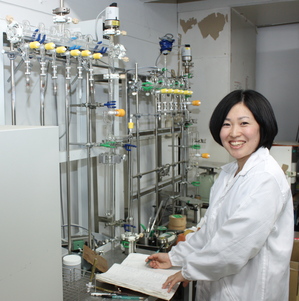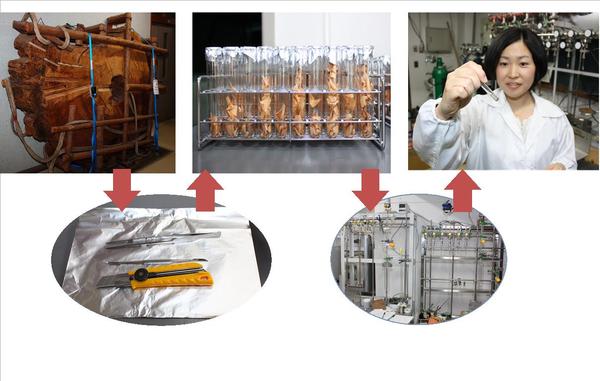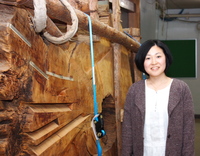
Fusa Miyake, a doctoral student at the Solar-Terrestrial Environment Laboratory, funded by the Japan Society for the Promotion of Science, has entered in the limelight with her research on cosmic rays. By extracting carbon 14 (14C) from the tree rings of an ancient cedar tree, she can determine the annual cosmic ray levels in the past. Her research shows us the changes in space environment and their influence on the Earth, and has attracted many scholars around the world, regardless of academic discipline. For instance, historians of the Middle Ages have shown their interest in her research, which might suggest that environmental changes caused by the cosmic ray outburst might have triggered important events in history. Further, studying the changes caused to the global environment by space environment changes in the past could help predict future changes, and enable us to take precautionary measures regarding their influence on the Earth. Her papers, in collaboration with Associate Professor Kimiaki Masuda from the same laboratory, have appeared in Nature1 and Nature Communication2, and gained coverage in various media.3 Learning from the past and contributing to the present and the future: Nagoya University Research did a short interview with Ms. Miyake, a leading researcher of the next generation.
1. "A signature of cosmic-ray increase in AD 774-775 from tree rings in Japan", F. Miyake, K. Nagaya, K. Masuda and T. Nakamura, Nature, 3 June, 2012.
2. "Another rapid event in the carbon-14 content of tree rings", F. Miyake, K. Masuda and T. Nakamura, Nature Communications, 23 April, 2013.
3. Agence Freance-Presse, National Geographic News, New Scientist, etc.
Why Did You Become a Researcher?
When I was a junior high school student I interviewed some researchers at Nagoya University and a curator at the Nagoya City Science Museum, as part of my integrated study class. I learned that there were many things in space still unexplained, and this motivated me to study astronomy and discover some of the answers. At that time I was intrigued by stars and the formation of the galaxy. After entering Nagoya University, I took various lectures on space and eventually became interested in the solar system. I would like to deepen our understanding of the system in which we live. It has become familiar to us to some extent, thanks to innovations in technology and the work of past researchers. Nonetheless, there is still much to be revealed. This is the motivation for me to continue studying.
Challenges in the Course of Research

I learned how to shave tree rings from the cedar tree 4 years ago, and began my research the following year. I measure the 14C levels in the tree rings, and determine the cosmic ray intensity. This research requires incessant concentration and absolute accuracy. I need plenty of patience and a lot of time to establish the 14C levels, and until this is done we cannot even guess whether or not the process will be fruitful. We use a 1900-year-old cedar tree, and it takes a whole month to gauge the 14C levels of just 30 years. The tree came to Nagoya University more than 20 years ago, and my predecessors had been investigating the 14C in the tree rings since that time. So far I have measured 600 years' worth of 14C levels in the tree rings. For the last two years our research has been receiving a lot of attention around the world. This is the outcome of our steady effort for more than 20 years.
Outlook for the Future
 I will keep measuring 14C levels in the tree rings from the same cedar tree, and try to find the same phenomena of cosmic ray outbursts, like those that occurred in AD 775 and AD 994, in different periods of history. In the short term, I aim to complete a continuous 14C data set of 2000 years from the cedar tree. In the long run, I would like to use much older trees as research materials, preferably more than 10,000 years old. I want to elucidate the changes in the cosmic environment over the past 10,000 years.
I will keep measuring 14C levels in the tree rings from the same cedar tree, and try to find the same phenomena of cosmic ray outbursts, like those that occurred in AD 775 and AD 994, in different periods of history. In the short term, I aim to complete a continuous 14C data set of 2000 years from the cedar tree. In the long run, I would like to use much older trees as research materials, preferably more than 10,000 years old. I want to elucidate the changes in the cosmic environment over the past 10,000 years.
Message to Young Students
I was bad at physics and math when I was a high school student, but I persevered so I could study astronomy. Even if there is something you do not do particularly well, it is important to keep trying your best and to pursue your interests.
Links
Previous Studies
"Another rapid event in the carbon-14 content of tree rings"
Nagoya University Press Release (2013/04/24) (Japanese)
"Another rapid event in the carbon-14 content of tree rings", F. Miyake, K. Masuda and T. Nakamura, Nature Communications, 23 April, 2013.
"A signature of cosmic-ray increase in AD 774-775 from tree rings in Japan"
Nagoya University Press Release (2012/05/25) (Japanese)
"A signature of cosmic-ray increase in AD 774-775 from tree rings in Japan", F. Miyake, K. Nagaya, K. Masuda and T. Nakamura, Nature, 3 June 2012.
National Geographic News (2012/07/07)
Royal Astronomical Society (2013/01/21)
Fusa Miyake Information
Solar-Terrestrial Environment Laboratory, Nagoya University
Related Article
Linking the Past to the Future -Carbon 14 Content in 1900 year-old Tree Rings-